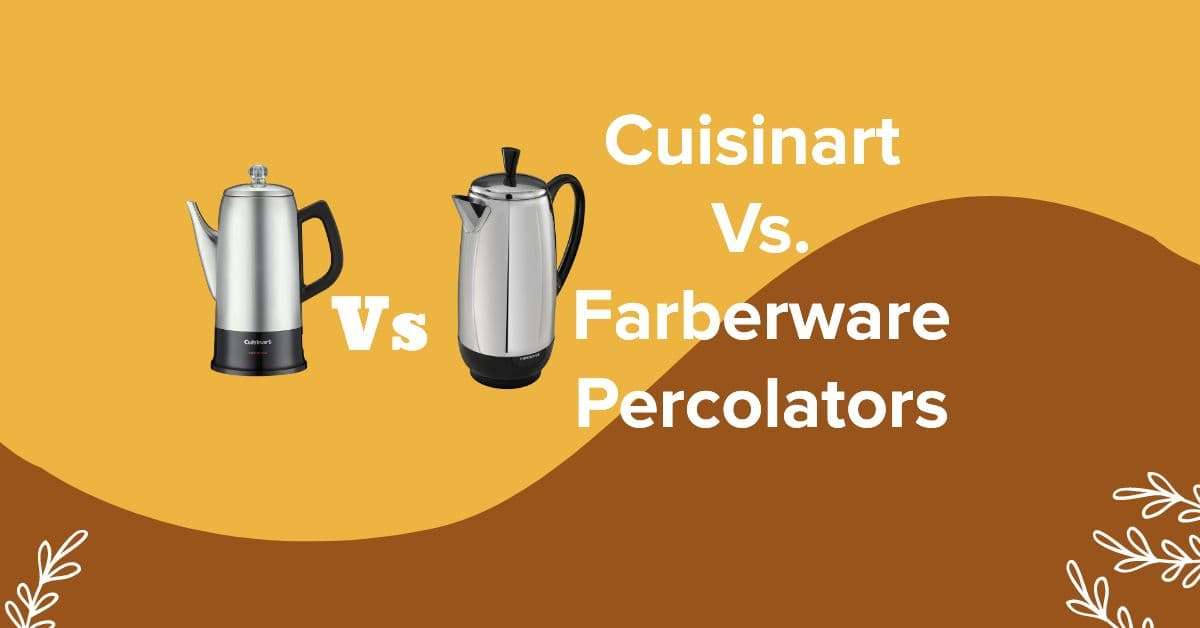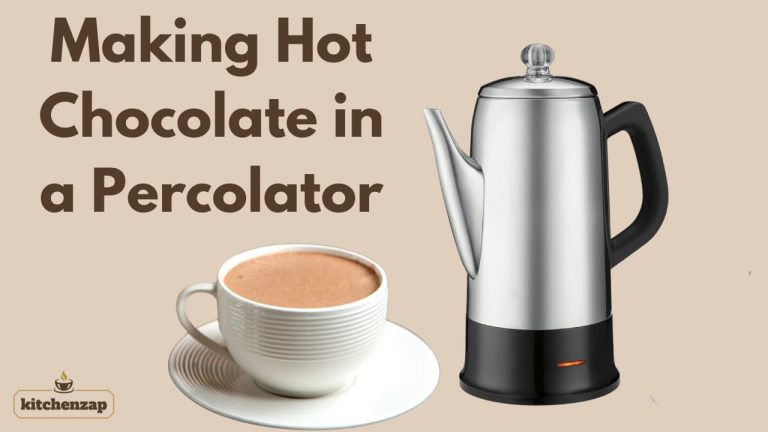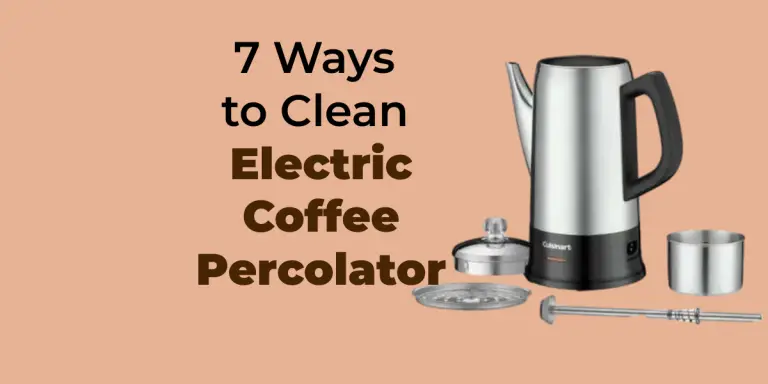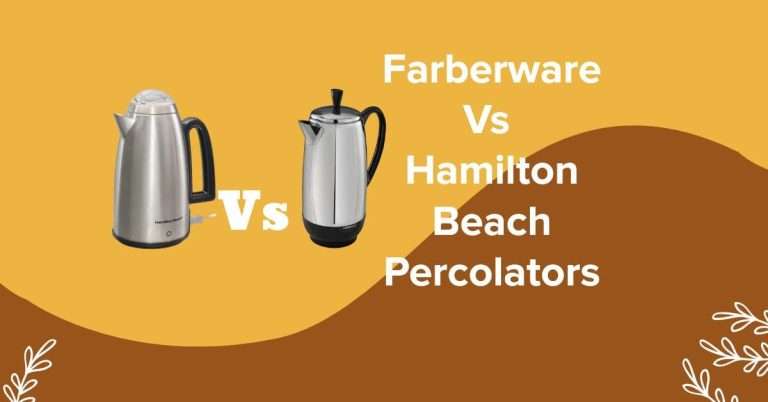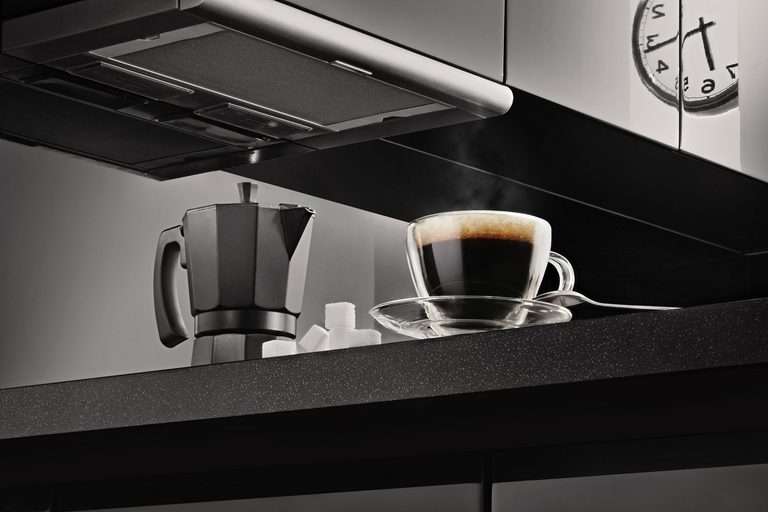Cuisinart Vs. Farberware Percolators: 19 Features You Want To Know
When it comes to percolators, there are many brands and models to choose from. Two of the most popular are Cuisinart and Farberware. After using both brands, I’m fully prepared to share my thoughts and experiences to help you choose the right percolator.
In this article, I’ll expand on the differences between Cuisinart vs Farberware percolators. We’ll dive into their capacity, brewing time, filters, ease of use, noise level, and more. By the end, you’ll have a better understanding of which brand and model is the best fit for you.
Key Takeaways
- Cuisinart percolators are more durable, have a higher capacity, faster brew times, and more features like auto shut-off and water level indicators. However, they are more expensive.
- Farberware percolators are more affordable but less durable. They have smaller capacities, slower brew times, and fewer features. However, some people prefer their classic, retro design.
- Cuisinart uses stainless steel and permanent filters. Farberware uses aluminum and paper filters. This affects taste, environmental impact, and ease of use.
- Cuisinart percolators are quieter, easier to use and clean. Farberware models are noisier and more difficult to clean.
- Cuisinart has better reviews and ratings overall. But Farberware remains a decent budget option for people who prioritize affordability.
The key differences come down to quality of materials, features, customizability, and ease of use. Cuisinart offers a more premium product while Farberware focuses on budget-friendliness. Consider your needs and preferences when deciding between the two brands.
Comparison Table Between Cuisinart and Farberware Electric Coffee Percolators
| Feature | Cuisinart Electric Percolator | Farberware Electric Percolator |
|---|---|---|
| Capacity | Typically offers models in 4-cup to 12-cup sizes | Commonly available in 4-cup to 8-cup sizes |
| Power (Watts) | Generally around 800 to 1000 watts for quick brewing | Usually ranges from 500 to 1000 watts, depending on the model |
| Build Quality | Stainless steel construction for durability and aesthetics | Stainless steel design, with some models having a more classic look |
| Features | Detachable cord, stay-cool bottom, no-drip spout. Some models may have a transparent knob to monitor brewing progress | Detachable power cord, stay-warm mode, robust handle. Models often feature a simple operation without excessive settings |
| Price Range | Mid to high, reflecting premium build and brand reputation | Generally more affordable, offering good value for the quality and features |
| User Reviews | Positive for durability, design, and coffee quality. Some concerns over the longevity of heating elements in select models | Highly rated for reliability, ease of use, and traditional brewing taste. Some feedback points to a preference for stronger coffee from these percolators |
| Additional Features | Some models come with advanced filtration systems to enhance flavor | Classic design elements appeal to traditionalists. Limited additional features focusing on straightforward brewing |
| Ease of Cleaning | Generally easy to clean with detachable parts; some models are dishwasher safe but manual cleaning is recommended to preserve longevity | Easy to disassemble and clean; most parts are dishwasher safe, but hand washing is advised for preserving finish and durability |
| Brewing Process | Fast brewing time due to higher wattage; automated keep-warm function. Some models have indicators for when brewing is complete | Traditional percolation process with a focus on simplicity; consistent brewing temperature for optimal flavor extraction |
| Coffee Flavor | Known for producing a smooth and flavorful cup of coffee; the advanced filtration system in some models can further enhance taste | Strong and robust coffee flavor, appealing to those who prefer a traditional percolator taste. Consistent extraction results in a rich and full-bodied cup |
Choosing Between Cuisinart and Farberware
Cuisinart is a solid choice for individuals who:
- Value Variety: Appreciate having a wider selection of sizes, accommodating anywhere from a small family to a large gathering.
- Prioritize Speed: Prefer their coffee ready swiftly, thanks to the higher wattage that Cuisinart percolators generally offer.
- Seek Enhanced Flavors: Enjoy a smoother cup of coffee, which is often the result of advanced filtration systems found in some Cuisinart models.
- Have Flexible Budgets: Are willing to invest a bit more for premium build quality, brand reputation, and additional features that may enhance their coffee brewing experience.
- Please refer to user guide or user manual or user guide (provided below in PDF) before first use
Farberware stands out for consumers who:
- Seek Simplicity and Value: Want a straightforward, no-frills coffee brewing experience without compromising on quality.
- Prefer Traditional Taste: Enjoy the robust and full-bodied flavor that comes from classic percolation, which Farberware has perfected over the years.
- Are Budget Conscious: Look for an affordable option that still delivers in terms of reliability and taste.
- Appreciate Durability and Easy Maintenance: Value a product that is not only built to last but also easy to clean and maintain, ensuring their coffee percolator remains a staple in their kitchen for years to come.
- Convenient capacity of 4 to 12 cups
1. Brand: Cuisinart and Farberware Are Two Popular Brands
Cuisinart and Farberware are two well-known brands in the coffee percolator world. Both brands have a reputation for producing high-quality kitchen appliances, but they have some key differences.
Cuisinart percolators have innovative structures and advanced features like brew strength control and temperature settings. They’re a great choice if you want customization in the brewing process.
Farberware products tend to have a no-frills approach to kitchen appliances. Their percolators are made to be simple and easy to use. They’re known for reliability and consistency. Ultimately, the choice between the two brands comes down to personal liking, budget, and features.
2. Design: Cuisinart and Farberware Percolators Have Different Designs
Cuisinart percolators have a sleek, modern design. Farberware percolators, on the other hand, have classic, traditional designs. Cuisinart percolators have a more modern and stylish look with a sleek silver finish and black accents.
In contrast, Farberware percolators have a more classic and traditional appearance, with a shiny silver finish and a retro design.
- Note: 1)Too coarse a grind, too little coffee, or insufficiently tamping the grounds before brewing can all lead to…
3. Capacity: Cuisinart Percolators Have a Higher Capacity
One of the key differences between farberware vs cuisinart is the capacity of the brewing chamber. Capacity, for your information, refers to the amount of coffee the percolator can brew at once.
If you think about it, the amount of coffee you can make is a crucial factor when choosing a coffee maker for your household or office.
Cuisinart percolators are known for their larger capacity. Some models can even hold up to 12 cups of coffee at once. Naturally, they’re a great choice for households or offices with multiple coffee drinkers or for those who love company.
The larger brewing chamber means you can make a large batch of coffee rather than having to make multiple smaller batches.
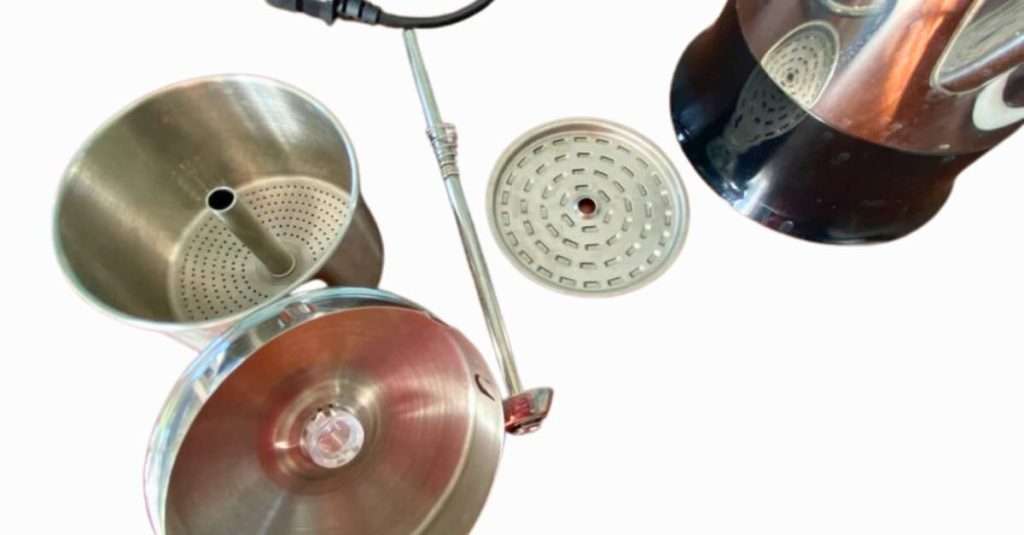
On the other hand, Farberware percolators have a smaller capacity. Most models hold up to 8 cups of coffee at once. While this may be less than Cuisinart percolators, it can still be enough for small households or offices with fewer coffee drinkers.
By the way, the actual size of a “cup” can vary between different brands and models of coffee makers. In general, a standard coffee cup is around 8 ounces. So, a 12-cup Cuisinart percolator can brew up to 96 ounces of coffee at once. An 8-cup Farberware percolator can brew up to 64 ounces of coffee.
- Note: 1)Too coarse a grind, too little coffee, or insufficiently tamping the grounds before brewing can all lead to…
When comparing Cuisinart vs Farberware percolators based on capacity, consider your personal needs and preferences. If you always make coffee for a large group of people, then a Cuisinart percolator may be the best choice.
If you only need to make coffee for a few people at a time, then a Farberware percolator may suffice.
4. Material: Materials Differ Between a Cuisinart vs. Farberware Percolator
Cuisinart percolators are made of stainless steel, while Farberware percolator is made of aluminum. Material is an essential consideration because it can affect the durability of your percolator. Generally, stainless steel performs best over time.
5. Price: Cuisinart Percolators are Pricier
In terms of price, Cuisinart percolators tend to be on the higher end of the spectrum. Actually, it’s not hard to predict a higher price for this brand, thanks to its advanced features and stylish designs.
Farberware percolators are more affordable and budget-friendly. So, they’re a great option for coffee lovers who want a reliable percolator without breaking the bank.
6. Brew Time: Cuisinart’s Brew Time is a Few Minutes, Farberware’s is 10-15 Minutes
What about brew time? This factor brings up another key difference between Cuisinart and Farberware percolators.
Brewing time refers to the amount of time it takes for the percolator to heat the water, brew the coffee, and dispense it into the carafe. If you’re usually in a rush to make coffee, you’ll likely lean toward the Cuisinart percolator.
Cuisinart percolators are designed to brew coffee quickly. In fact, some models can complete the brewing process in just a few minutes. This is an advantage for those who are rushed in the morning or who need their coffee pronto.
The faster brewing time also means the coffee is less likely to be over-extracted or burnt. As a result, your coffee will be smoother without sacrificing that bold flavor.
On the other hand, Farberware percolators have a slower brewing time. They take about 10-15 minutes to brew. Why? They use a lower heat setting and a longer brewing cycle to extract the most flavor from the coffee beans.
While this may result in a richer and more robust cup of coffee, it can be a turnoff if you’re short on time or need your coffee quickly.
The actual brewing time of a percolator can vary depending on several factors. Factors include the amount of coffee being brewed, the type of coffee beans, and the water temperature.
Generally, Cuisinart percolators have a faster brewing time than Farberware ones due to their higher heat setting and shorter brewing cycle.
When selecting Cuisinart vs. Farberware percolators based on brewing time, be sure to consider your personal needs. If you need your coffee quickly and don’t want to wait long for it to brew, then a Cuisinart percolator may be the best choice.
If you don’t mind waiting a little longer, then a Farberware percolator may be the better option.
- Please refer to user guide or user manual or user guide (provided below in PDF) before first use
7. Filters: Cuisinart Uses a Permanent Stainless Steel Filter, Farberware Uses Paper Filters
Another difference between Cuisinart and Farberware percolators is the filter used during the brewing process. As you may already know, a filter is a key part of a percolator. It’s responsible for removing coffee grounds and impurities from the brewed coffee.
Cuisinart percolators use a permanent stainless steel filter built right into the brewing basket. It’s a huge advantage because you don’t need to buy or replace paper filters, saving you money over time. The stainless steel filter is also more environmentally friendly than paper filters since it’s reusable.
In contrast, Farberware percolators require paper filters during the brewing process. You must replace these paper filters must after each use.
So, it’s an ongoing expense. However, some people prefer using paper filters as they can help to improve the coffee’s clarity and prevent grounds from entering the cup.
It’s worth noting that the filter used in a percolator can also affect the taste of the coffee. Paper filters can absorb some of the oils and flavors from the coffee, resulting in a smoother and less bitter cup of coffee. Others prefer the robust and bold flavor achieved using a permanent stainless steel filter.
So, when choosing between a Farberware percolator vs. Cuisinart percolator based on filters, it’s essential to consider your personal requirements. If you want to save money and reduce waste, a Cuisinart percolator with a permanent stainless steel filter may be the best choice.
If you prefer the taste of coffee brewed with paper filters, a Farberware percolator that requires paper filters may be the better option.
8. Auto Shut-Off: Cuisinart Has It, Farberware Doesn’t
One key difference between Cuisinart and Farberware percolators is the auto shut-off feature. Cuisinart percolators have an auto shut-off feature that automatically turns off the percolator once the brewing process is complete.
This valuable feature can help reduce the risk of accidents or fires, conserve energy, and lower your electricity bill. However, Farberware percolators do not have this feature, so you must manually turn it off.
While this may be fine for some users, those who tend to forget may find it less convenient. Notably, Farberware percolators still have safety features such as a heat-resistant handle and base.
9. Water Level Indicator: Cuisinart Has It, Farberware Doesn’t
So, when it comes to water level indicators, which is better: Farberware or Cuisinart? Cuisinart percolators have a water level indicator on the side, which allows users to easily adjust the amount of water for their desired coffee strength. Farberware percolators lack this feature, requiring users to estimate the water needed.
While some Farberware models have a transparent plastic knob on the lid, it’s less precise than a reliable water level indicator.
The presence or absence of a water level indicator can heavily influence your decision. If you prioritize a water level indicator, Cuisinart percolators are the better option. Otherwise, a Farberware percolator may be a suitable choice.

10. Warranty Comparison
Of course, when you buy any product, it’s worth noting the warranty. The same goes for Cuisinart and Farberware percolators. Cuisinart percolators have a limited 3-year warranty. Farberware percolator warranties are a bit more limited, at only one year.
11. Ease of Use: Cuisinart Percolators Are Easier to Use
How can you look at percolator models without considering which one is more simple to use? Cuisinart percolators are generally easier to use than Farberware percolators.
Cuisinart models have an electric heating element, eliminating the need for a stove and making them portable and quick to use. They also use a permanent stainless steel filter, which is more eco-friendly and convenient.
Farberware percolators require a stove or hot plate and paper filters, which you must replace after each use. Cuisinart percolators may be the better option for users who prioritize ease of use.
However, those who prefer a more traditional brewing method may like Farberware percolators better.
12. Cleaning: Cuisinart Percolators Are Easier to Clean
When choosing between Cuisinart and Farberware percolators, cleaning is a crucial factor to consider. So, is Farberware or Cuisinart better in terms of cleaning? In short, Cuisinart percolators are more durable and easier to clean than Farberware percolators.
Many Cuisinart models have removable parts that can be easily cleaned and reassembled. This ability makes them a better option for users who want to maintain the quality of their coffee by thoroughly cleaning the percolator after each use.
Farberware percolators do not always have removable parts, making them more challenging to clean.
- Note: 1)Too coarse a grind, too little coffee, or insufficiently tamping the grounds before brewing can all lead to…
13. Cuisinart vs. Farberware Percolator Brewing Temperature
Now, let’s look at the brewing temperatures of Cuisinart and Farberware percolators. Cuisinart percolators can brew coffee at a higher temperature than Farberware percolators. The result? A richer and more flavorful brew.
Cuisinart percolators also have a brew strength control feature, allowing you to adjust your coffee’s strength. Farberware percolators don’t have this feature.
One of the key factors that can impact the taste and quality of your coffee is the brewing temperature. As mentioned, Cuisinart percolators brew coffee at a higher temperature than Farberware percolators.
This higher temperature can result in a more delicious cup of joe that brings out your coffee beans’ full flavors.
In addition to brewing temperature, the strength of your coffee can also impact its flavor profile. The Cuisinart percolator’s brew strength control feature lets you adjust the potency of your coffee to your liking.
This is a great feature for coffee fans who prefer their coffee stronger or milder than the standard brew.
In contrast, Farberware percolators don’t have a brew strength control feature. So, users are limited to the traditional strength of the coffee brewed by the percolator.
Users who prefer a stronger or milder brew might struggle without this feature. They may have to use more or fewer coffee grounds to achieve the desired strength.
All in all, the higher brewing temperature of the Cuisinart percolator and its brew strength control feature makes it a great option for users who want coffee customization. However, if you don’t mind a standard brew and don’t need the extra features, then you could opt for the Farberware.
14. Noise Levels: Cuisinart is Quieter
If you’re sensitive to sound, the volumes of these two percolators are something to consider. Cuisinart and Farberware percolators differ in their noise level during the brewing process.
So, is Cuisinart good brand when it comes to noise level? Yes! Cuisinart percolators operate quietly. In contrast, Farberware percolators can be quite noisy.
The Farberware percolator can be quite loud due to its high temperature and its metal basket.
Cuisinart percolators use a permanent stainless steel filter that reduces noise. As a bonus, it eliminates the need for paper filters. This feature makes it more convenient to use a Cuisinart percolator, improving your brewing experience.
However, if the noise level doesn’t matter to you, the Farberware percolator may still be a suitable choice based on other features.
15. Brew Cycle Length: Cuisinart Percolator’s is Shorter
Now, let’s examine the brew cycle length of Cuisinart and Farberware percolators. For starters, what’s the brew cycle? This term refers to the time it takes for the percolator to brew a full pot of coffee. Cuisinart percolators have a shorter brew cycle than Farberware ones.
So, you can brew coffee faster with a Cuisinart percolator. Brew cycle length is a key consideration if you’re short on time in the morning.
It’s also helpful if you want to brew multiple pots of coffee in a shorter time. With a Cuisinart percolator, you can enjoy that fresh pot of coffee in just a few minutes!
In contrast, Farberware percolators have a longer brew cycle. As a result, it may take longer for the coffee to be ready.
It might not bother some coffee drinkers, but it can be inconvenient for others. Also, a longer brew cycle affects your coffee’s quality. Over brewing can result in a bitter taste, so having a shorter brew cycle can help ensure you brew the coffee to perfection.
16. Farberware vs. Cuisinart Percolator Cord Length
If you’ll need to strategically place your percolator based on a limited number of wall plugs, consider the cord length. And yes, Cuisinart and Farberware percolators both have cords.
The Cuisinart percolator has a longer cord than the Farberware percolator. This can help if you need to put it far away from an outlet.
17. Farberware vs. Cuisinart Coffee Percolator Capacity
As you may have guessed, Cuisinart and Farberware percolators have different capacities. The Cuisinart percolator actually has options in this department. So, you can select a 4, 6, 8, or 12-cup percolator. The Farberware percolator has 4, 8, and 12-cup options.
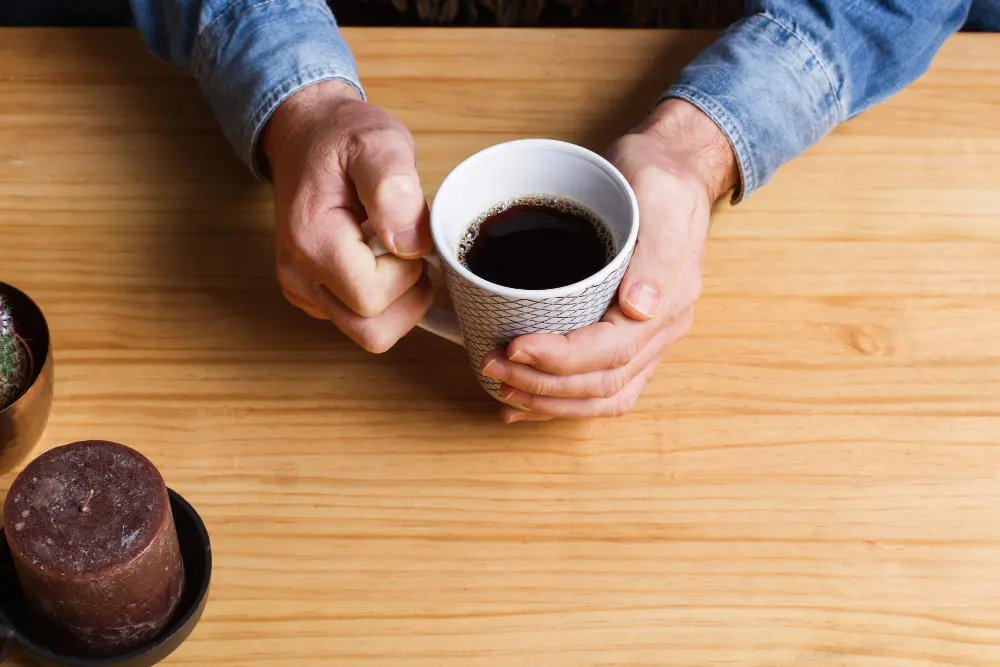
18. Cuisinart vs. Farberware Percolator Durability
By now, you know that Cuisinart and Farberware percolators have quite a few differences and offer features to meet different needs. But how will they hold up after you buy them? Let’s discuss durability. In general, Cuisinart percolators are more durable, thanks to higher-quality materials.
Cuisinart percolators are crafted with precision and attention to detail, leading to excellent durability. With sleek stainless steel bodies and robust materials, these percolators look modern and stylish while standing up to the test of time.
Thanks to stainless steel’s resistance to rust and corrosion, your percolator will continue to perform well through years of regular use. You’ll see minimum wear and tear over time.
Now, let’s see about Farberware percolators. They’re made of lower-grade materials like aluminum and plastic. Sadly, these materials aren’t as durable as stainless steel.
The lower-grade materials used in Farberware percolators are prone to dents, scratches, and other forms of damage.
Also, don’t be surprised if you see cracks or breakage on the plastic components after regular use. These factors certainly put a damper on this percolator’s durability rating.
To sum it up, if durability is a big factor for you, a Cuisinart percolator is your best bet. Farberware percolators could be more prone to wear and tear over time due to their lower-grade materials.
19. Cuisinart Percolator Customer Reviews and Ratings
So, is Cuisinart better than Farberware when it comes to percolators? Cuisinart and Farberware percolators both have decent reviews. However, Cuisinart takes the lead in customer ratings and reviews.
Their reviews suggest they might be a more popular and well-liked product overall. On Amazon, the Cuisinart percolator has an average 4.4-star customer review, and Farbeware has the same 4.4-star rating.
Conclusion
In summary, when it comes to choosing between Cuisinart and Farberware percolators, there are many factors to consider. Both brands offer unique features and benefits, but it ultimately comes down to personal preference and your specific needs.
Whether you prioritize brewing temperature, ease of use, noise level, or durability, there’s a percolator out there for you! By considering these differences, you can make a wise decision and enjoy a delicious cup of coffee from your new percolator in no time!

